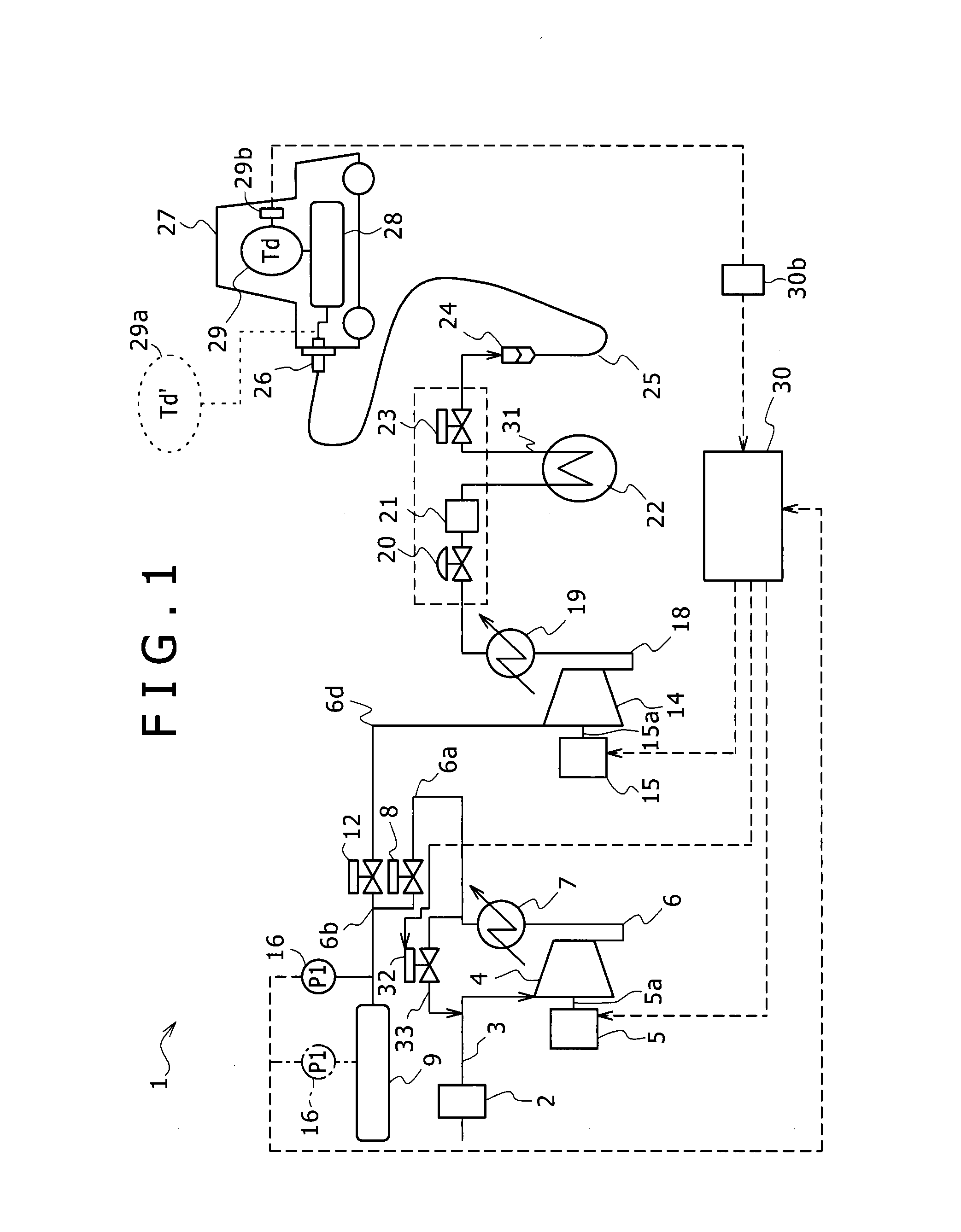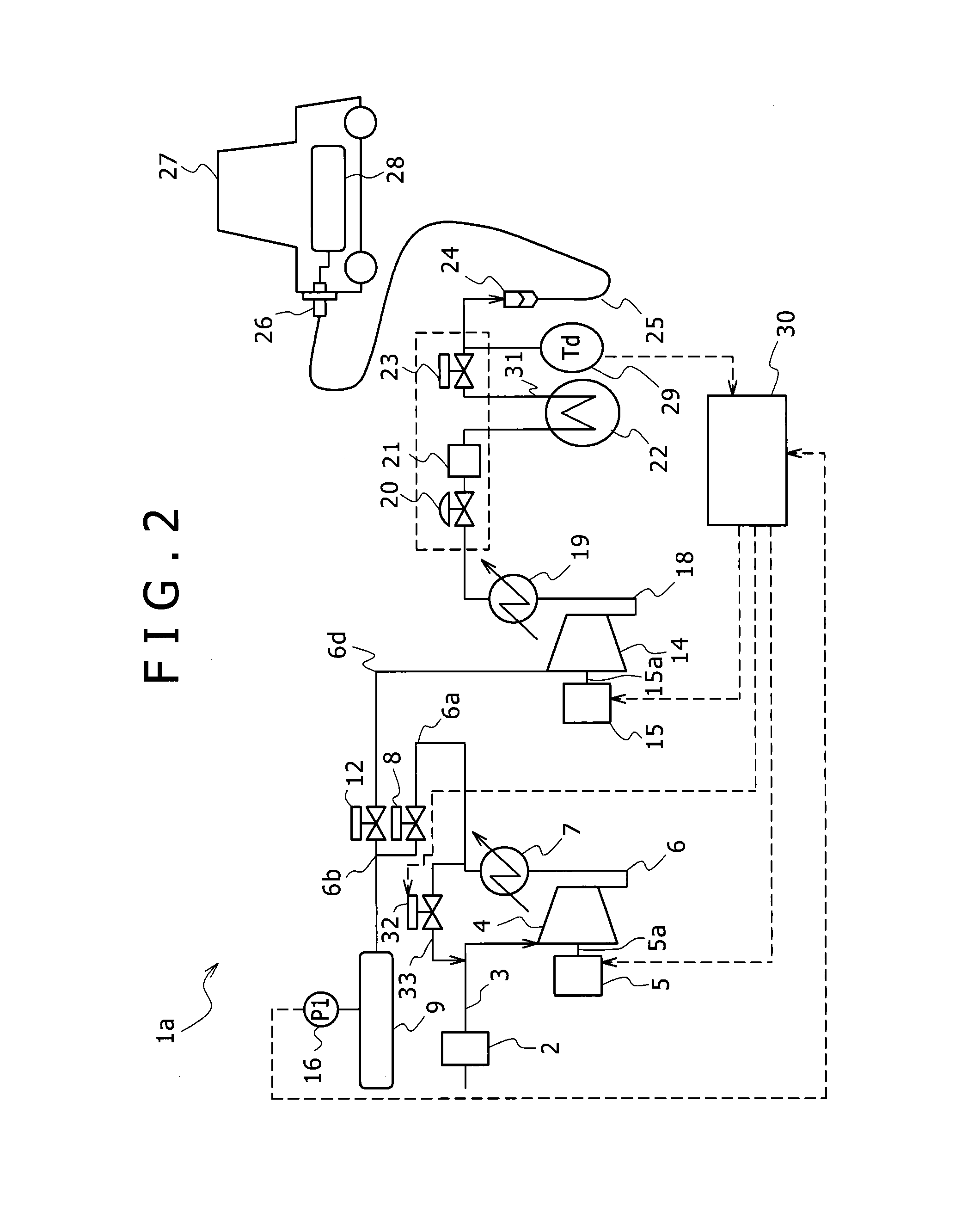Hydrogen station
a hydrogen station and hydrogen technology, applied in the field of hydrogen stations, can solve the problems of large expansion of facilities, inability to perform uniform temperature control in hydrogen stations, and inability to meet the needs of customers, and achieve the effect of suppressing an increase in the internal temperature of hydrogen tanks and easy controlling hydrogen temperatur
- Summary
- Abstract
- Description
- Claims
- Application Information
AI Technical Summary
Benefits of technology
Problems solved by technology
Method used
Image
Examples
first embodiment
[0027]FIG. 1 illustrates a configuration of a hydrogen station 1 according to a first embodiment of the present invention. The hydrogen station 1 has a configuration in which hydrogen (a hydrogen gas) is first supplied from a hydrogen supply source (not shown) to a low-pressure-stage reciprocating compressor (a low-pressure-side reciprocating compressor: a first compressor) 4 through a supply passage 3 equipped with a filter 2.
[0028]A driver 5 (a motor or the like) is connected to the low-pressure-side reciprocating compressor 4 through a drive shaft 5a. The low-pressure-side reciprocating compressor 4 is driven by the rotation of the drive shaft 5a of the driver 5. The driver 5 is a motor which is driven by an inverter. The revolution of the driver 5 is controllable. That is, the drive shaft 5a may be rotated at an arbitrary revolution. Furthermore, the driver 5 may be any machine of which the revolution is controllable, and is not limited to the motor which is driven by the invert...
second embodiment
[0081]FIG. 4 illustrates a configuration of a hydrogen station 1b according to a second embodiment of the present invention. The hydrogen station 1b has substantially the same configurations as those of the hydrogen station 1 according to the first embodiment. Furthermore, the same reference signs will be given to the same configurations as those of the first embodiment and the specific description thereof will not be repeated.
[0082]The hydrogen station 1b of this embodiment is different from the hydrogen station 1 of the first embodiment in that two intermediate pressure accumulators (the first and second intermediate pressure accumulators 9 and 11) are provided and a flywheel 31 is provided in the drive shaft 15a connecting the high-pressure-side reciprocating compressor 14 to the driver 15. Further, the hydrogen station 1b of this embodiment is different from the hydrogen station 1 of the first embodiment in that the bypass passage 33 is not provided.
[0083]Specifically, the confi...
third embodiment
[0095]FIG. 5 illustrates a configuration of a hydrogen station 1c according to a third embodiment of the present invention. The hydrogen station 1c has substantially the same configurations as those of the hydrogen station 1b according to the second embodiment. Furthermore, the same reference signs will be given to the same configurations as those of the second embodiment and the specific description thereof will not be repeated.
[0096]In the hydrogen station 1b of the second embodiment, the revolution of the driver 15 is controlled based on the temperature Td, but the hydrogen station 1b of this embodiment has a difference in that the opening degree of the adjustment valve 32 is adjusted based on the temperature Td so as to adjust the amount (the return amount) of the hydrogen returned from the discharge side of the high-pressure-side reciprocating compressor 14 to the suction side thereof through a return passage 33 to be described later.
[0097]In the hydrogen station 1c, the return...
PUM
| Property | Measurement | Unit |
|---|---|---|
| inversion temperature | aaaaa | aaaaa |
| inversion temperature | aaaaa | aaaaa |
| pressure | aaaaa | aaaaa |
Abstract
Description
Claims
Application Information
 Login to View More
Login to View More - R&D
- Intellectual Property
- Life Sciences
- Materials
- Tech Scout
- Unparalleled Data Quality
- Higher Quality Content
- 60% Fewer Hallucinations
Browse by: Latest US Patents, China's latest patents, Technical Efficacy Thesaurus, Application Domain, Technology Topic, Popular Technical Reports.
© 2025 PatSnap. All rights reserved.Legal|Privacy policy|Modern Slavery Act Transparency Statement|Sitemap|About US| Contact US: help@patsnap.com



